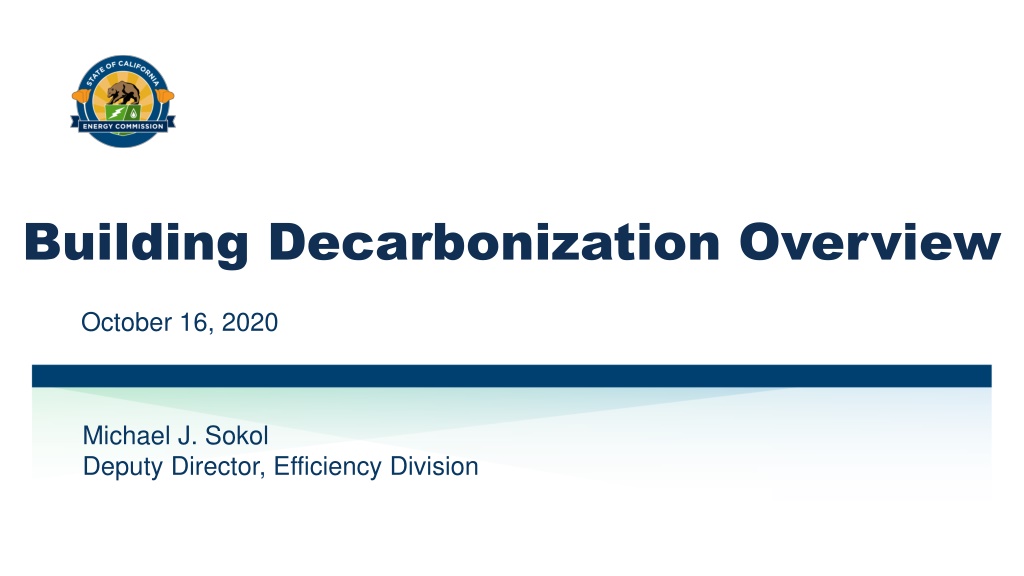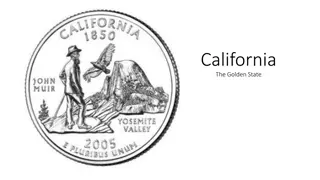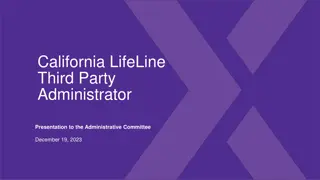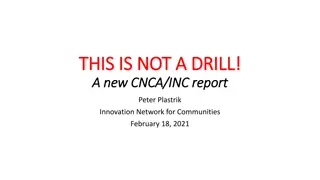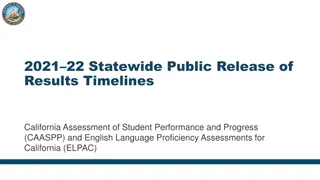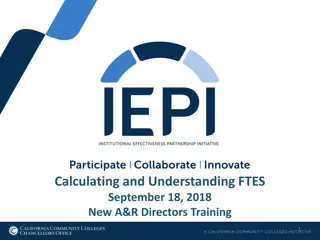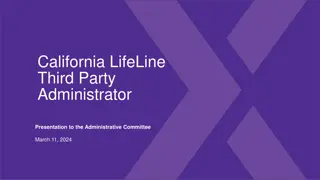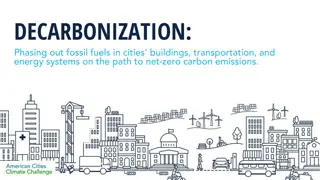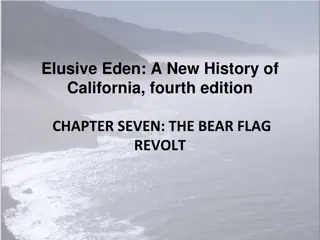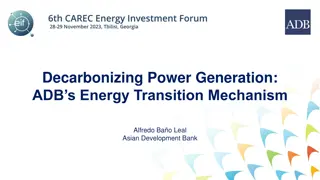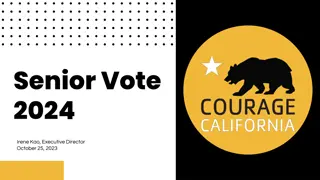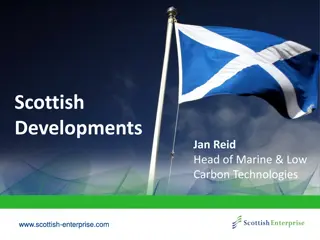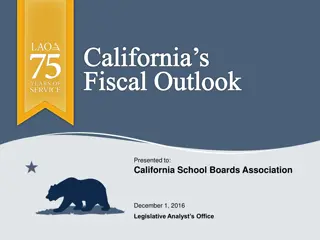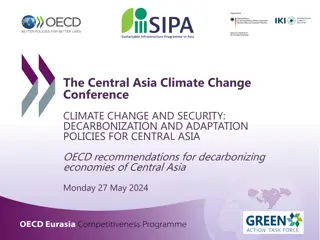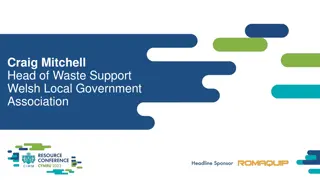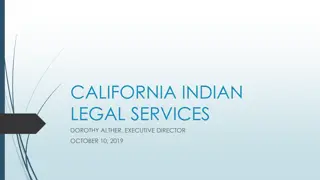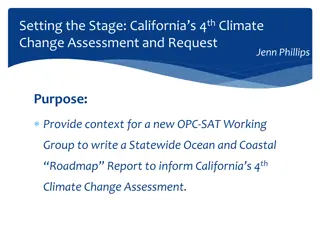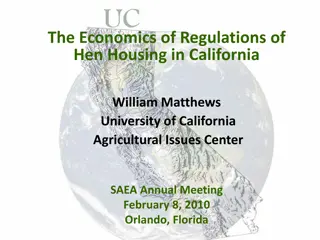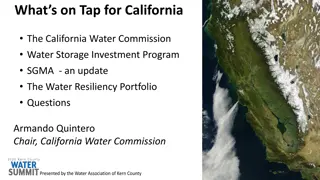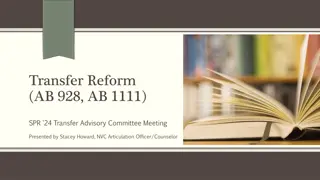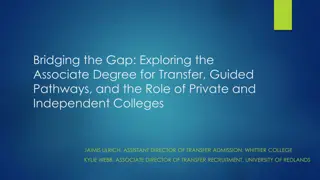California Building Decarbonization Initiatives Overview
This overview delves into California's efforts towards reducing greenhouse gas emissions in commercial and residential buildings by 40% below 1990 levels by 2030. It covers key proceedings, strategies, assessment timelines, load management standards, and utility programs aimed at achieving decarbonization. The focus is on legislation, pilot programs, barriers, impacts, and future steps in building decarbonization.
Download Presentation

Please find below an Image/Link to download the presentation.
The content on the website is provided AS IS for your information and personal use only. It may not be sold, licensed, or shared on other websites without obtaining consent from the author. Download presentation by click this link. If you encounter any issues during the download, it is possible that the publisher has removed the file from their server.
E N D
Presentation Transcript
Building Decarbonization Overview October 16, 2020 Michael J. Sokol Deputy Director, Efficiency Division
CECs Key Building Decarbonization Proceedings Assembly Bill 3232 Building Decarbonization Assessment Load Management Standards Senate Bill 49 Flexible Demand Appliance Standards Senate Bill 1477 Building Initiative for Low-Emissions Development (BUILD) program 2022 Building Energy Efficiency Standards *Also a range of other CEC and other agency policies and proceedings related to building decarb that will not be covered in detail today 3
Assembly Bill 3232 Building Decarbonization Assessment Primary question How can California reduce GHG emissions in its commercial and residential buildings 40% below 1990 values by 2030? Strategies Studies and Pilot Programs Barriers and Impacts Findings Next Steps 4
AB 3232 Building Decarbonization Assessment Timeline Workshop/Milestone Date Workshop: Building Decarbonization Assessment December 4, 2019 Webinar: Fuel Substitution Scenario Analysis Tool February 27, 2020 Webinar: Building Decarb Opps and Challenges May 22, 2020 Webinar: Fuel Substitution Scenarios June 9, 2020 Post: Draft Building Decarb Assessment December 31, 2020 Webinar: Draft Building Decarb Assessment January 2021 Post: Proposed Building Decarb Assessment April 2021 Vote: CEC Business Meeting April 2021 Deliver: Assessment to Legislature June 1, 2021 2021 IEPR: Update on topic/issues November 2021 6
Load Management Standards Utility Programs for Electrical Load Management Consumer Protection Voluntary & Automatic Save Money & Reduce Impacts Load management aims to automatically shift flexible electricity use without reducing customer quality of service. 7
Load Management Standards 2019-2021 Rulemaking In Progress Rate Database Load Serving Entities 1 Electric Vehicle Charging Batteries Electric Water Heating Smart Plugs Space Heating & Cooling Aggregators & Automation Manufacturers DR signals DR Devices Responsive Devices Rates 1. Load Serving Entities include IOUs, POUs, CCAs, Etc.
Load Management Standards LMS 19-OIR-01 Rulemaking Schedule 2021 JAN: Publish Draft Staff Report 2021 FEB: Workshop on Draft Staff Report 2021 MAY: Final Report 2021 JUNE: Formal Rulemaking 2021 Q4: Adopt Final Rules 9
Senate Bill 49 Requirements Requires CEC to develop Flexible Demand Appliance Standards, in coordination with LSEs and CPUC Cost-effective, including GHG and grid benefits Requires consumer consent Open source and user-friendly Cybersecurity Report on progress in the Integrated Energy Policy Report 10
Appliance Load Shift Potential Source: Final Report, CPUC working group on Load Shift January 31, 2019 11
Benefits to California Support efforts to decarbonize California's energy and building sectors Improve grid reliability and emergency response capability Make utility bill savings available to all consumers Reduce future electricity sector infrastructure costs 12
Steps Towards New Standards Order Instituting Rulemaking October 2020 Invitation to Participate Q4 2020 Public Workshop Q4 2020 Draft Staff Report Q2 2021 Initiate Formal Rulemaking Q3 2021 Initial Standards Adopted Q2 2022 * All dates are tentative based on results of research and pre-rulemaking activities 13
Senate Bill 1477 Summary BUILD Promote GHG emission reductions and bill savings in new low-income residential buildings TECH Statewide market development for low- emission space and water heating equipment for new and existing residential buildings 3rd Party Implementer $120 million Implement outreach strategies for hard-to-reach customers Goal Administrator Budget LI/DAC Component CEC $80 million $60 million for new low-income residential housing Projects are offered technical assistance Implement an outreach plan to encourage applicants No. low emission systems installed Projected utility bill savings $/MT avoided GHG emissions Evaluation Metrics Market share for eligible technology Projected utility bill savings $/MT avoided GHG emissions 14
SB 1477 Key Milestones Date 9/13/2018 1/31/2019 4/8/2019 7/16/2019 7/30/2019 2/12/2020 3/26/2020 Milestone SB 1477 approved by Governor CPUC instituted building decarb rulemaking (R.19-01-011) Joint agency workshop, Los Angeles CPUC files SB 1477 Joint Staff Proposal Public workshop, San Francisco CPUC Proposed Decision establishing pilot programs CPUC adopted Decision establishing framework and requirements (D.20-03-027) Joint agency public workshop on BUILD Implementation Plan, virtual CEC staff submitted the initial BUILD Implementation Plan to CPUC Updated BUILD Implementation Plan submitted to CPUC 6/15/2020 7/24/2020 9/29/2020 15
SB 1477 Next Steps Date Q4 2020 Q1 2021 Q2 2021 Milestone CEC issue RFP for technical assistance provider CEC publish draft BUILD Program guidelines CPUC finalize contract with TECH Implementer and BUILD/TECH Evaluator CEC publish final BUILD Program guidelines Launch TECH Initiative Launch BUILD Program Q3 2021 Q3 2021 Q3 2021 16
2022 Building Energy Efficiency Standards - Highlights Multifamily Restructuring to set a foundation for improved compliance, simplification, and setting more appropriate requirements for the multifamily industry Contributing to California's energy and climate goals through support of electric construction to reduce greenhouse gas emissions, grid integration to support the transition to renewables, and innovative measures that move beyond keeping up with model codes Examining incentive concerns or needs related to Controlled Environment Horticulture, controls for building systems measures, and software and modeling challenges. Enhancing electric and PV measures to ensure buildings are best equipped to benefit from renewable energy resources. 17
2022 Goals for Decarbonization & PV Building Electrification Baselines For: 1. Low-rise Residential Buildings 2. High-rise Multifamily 3. Selected Nonresidential Occupancies PV & Battery Storage Requirements For: 1. High-rise Multifamily 2. Selected Nonresidential Occupancies Support development of local reach codes moving toward decarbonization 18
Proposed Measures Connected to Decarbonization Nonresidential (6 measures) 1. Demand Response Lighting Systems 2. Thermal Energy Storage Systems 3. Heat Pump Water Heaters (HPWH) with Load Management Capabilities 4. Communications Protocol Clean Up 5. HVAC Controls Dedicated Outdoor Air Systems 6. Drainwater Heat Recovery Multifamily (3) 1. Central HPWH 2. Ducted Heat Pump 3. Appliances and Plug Loads MF Single Family (9) 1. Alterations and Additions: prohibit electric resistance water heating 2. Alterations and Additions: prohibit electric resistance space heating 3. Alterations and Additions: Compliance Options for Alterations 4. Alterations and Additions: Compliance Options 5. Battery Storage Systems 6. HVAC Load shifting 7. HPWH Load shifting 8. Home Energy Management 9. Variable Capacity HVAC Compliance Software Revisions 19
2022 Building Standards Update Schedule 2022 STANDARDS UPDATE SCHEDULE DATE MILESTONES Updated Weather Files November 2018 - November 2019 November 2018-December 2019 November 2018-July 2019 August 2019 to October 2020 August 2020-October 2020 February 2021 July 2021 July 2021 to November 2021 December 2021 December 2021 January 2022 Metric Development Measures Identified and approval Stakeholder meeting/workshop & final staff workshop CASE Reports submitted to the CEC 45-day Language Hearings Adoption of 2022 Standards at a Business Meeting Staff work on Software, Compliance Manuals, Electronic Documents Available to Industry Approval of the Manuals Approval of the Energy Standards at CBSC Software, Compliance Manuals, Electronic Documents Available to Industry January 1, 2023 Effective Date 20
For More Information Proceeding Website Primary Contact 19-DECARB-01 Docket Jennifer Nelson Jennifer.Nelson@energy.ca.gov AB 3232 Building Decarbonization Assessment 2020 Load Management Rulemaking Gabriel Taylor Gabriel.Taylor@energy.ca.gov Load Management Standards Senate Bill 49 Flexible Demand Appliances Pierre DuVair Pierre.DuVair@energy.ca.gov 2022 Building Energy Efficiency Standards Building Initiative for Low-Emissions Development Program Payam Bozorgchami Payam.Bozorgchami@energy.ca.gov Building Energy Efficiency Standards SB 1477 BUILD Jordan Scavo Jordan.Scavo@energy.ca.gov 21
